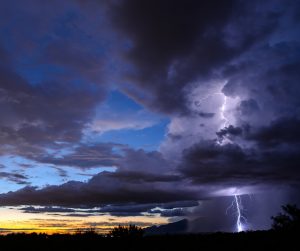There’s a trigger for anxiety you may not have realized. It’s especially true for highly sensitive people and dogs.
Have you ever had a dog that was afraid of thunder storms? You may have noticed they become agitated before the storm arrives. You might think the anxiety is caused by lightning and thunder (and the dog will begin to associate those with the sensation) but it’s not. The trigger is a change in the electrical charge of the atmosphere and the barometric pressure. Barometric pressure is the weight of the atmosphere that surrounds us. Shifts in barometric pressure can create the feeling of anxiety for many dogs (and cats) and highly sensitive people. Lower barometric pressure is also associated with increased pain, migraines and depression for some people. (More about the electrical charge later).
Tuesday night and Wednesday I felt “waves of anxiety”. You know that feeling like something’s not quite right? Like there’s something scary happening when there isn’t? Your adrenaline spikes a bit. That’s what I was experiencing. When this happens, I take a deep breath, exhaling slowly because a slow exhale cues the body to calm down. I feel into my body to see if there is an emotion or thought I’ve been avoiding. Sometimes fearful thoughts are creeping around in our head without our full consciousness and we can be pretty good at avoiding them. When I “check in” to my body and don’t detect f.e.a.r. (false evidence appearing real), I know there’s another reason for the sensation.
By morning, when the storm rolled in, the sensations of “anxiety” intensified. My body felt like I drank a large highly caffeinated cup of coffee. I felt wired. I suspected it was the barometric pressure but I checked into my body just in case. There were no emotions or thoughts behind the anxious feeling. I took some deep, slow breaths and went into my heart centered meditation. The sensations didn’t instantly disappear but after about 5 minutes my body calmed down…until a few hours later, when it all started again.
Let me explain what’s going on with these sensations without going into a science lecture (not like I could anyway). When the barometric pressure drops, there’s less “weight” or pressure on the outside of your body so tissues (like those around joints) expand. Think of barometric pressure like Spanx…when the pressure drops the Spanx comes off and you expand. This expansion, also known as inflammation causes pain for some people. At the same time the body responds to the inflammation by increasing cortisol and adrenaline. When you’re already sensitive to spikes of cortisol or adrenaline, this sensation feels like anxiety. And if you have something in your life you’re worried about, that worry will intensify.
Another affect of the storm coming in has to do with the electrical charge in a storm. Atoms carry either a positive or negative charge. When the storm comes in and the barometer falls, the positive ions increase which also affects our stress hormones. This happens to any mammal because all have adrenal glands which is why we and our dogs sometimes respond the same way. Leaving the science lab now…
The bottom line is storms and periods of low barometric pressure can leave you feeling like you stuck your finger in a wall socket or sucked down two gallons of Starbucks coffee. Here’s what will help you manage these sensations.
7 Steps to Calm Anxiety from Atmospheric Pressure Changes
- Check in to your current thoughts. Are you contributing to your sensation of anxiety through fearful thoughts? If you have anxious thoughts, find a way to let them go (more on this in the near future).
- Breathe into the sensation allowing it to pass through your body. Use the 4-7-8 breathing technique. Inhale through your nose to a count of 4, hold the breath for a count of 7 and exhale slowly out through your mouth to a count of 8. Repeat until you feel your body relax. This can take 5-15 minutes.
- Let go of judgment. This is important. Not judging the feeling and just noticing it keeps you from giving it more energy. As soon as you go to “I hate this”, “Why does this always happen”, “Why can’t I stop this, I should be able to stop this”… you amplify anxiety. This sensation is not any different than feeling cold when the temperature drops.
- Use Heart Centered Meditation. Heart centered meditation generates a deep feeling of love and safety. When you feel safe and loved your body calms. Remember this is an automatic response from your body. It is not a real threat. Tell your body you are safe.
- Avoid Caffeine and Alcohol. These will make the effects worse. If your body is used to having caffeine every day reduce your dose so you have just enough to avoid withdrawal symptoms. Alcohol may relax you at first but then it will spike your hormones resulting in a bigger crash later.
- Run for your life. Well not really. But running, biking fast or any other activity that moves the body will be useful because it burns off adrenaline. Your body is responding to the change in pressure with a flight/fight response. Running or other exercise completes the cycle so you come back to calm.
- Take the pressure off. Recognize you have a sensitive body. This sensitivity is meant to be honored as a gift. Be kind and gentle with yourself until the atmospheric pressure rises. Don’t over extend yourself.
As I finish this article the low pressure is still hovering over Amherst and the sensations come and go. I’m meditating more often, getting some exercise and setting the bar low for myself today. After all, I’m a highly sensitive empath and that’s okay. My sensitivity allows me to communicate with animals and beings in spirit, sense things others cannot, and know when others are being authentic with me.